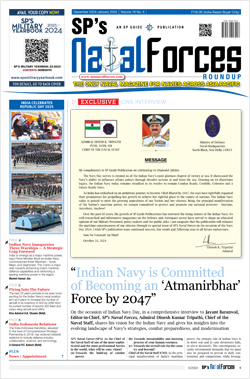INDIAN ARMED FORCES CHIEFS ON OUR RELENTLESS AND FOCUSED PUBLISHING EFFORTS

The insightful articles, inspiring narrations and analytical perspectives presented by the Editorial Team, establish an alluring connect with the reader. My compliments and best wishes to SP Guide Publications.

"Over the past 60 years, the growth of SP Guide Publications has mirrored the rising stature of Indian Navy. Its well-researched and informative magazines on Defence and Aerospace sector have served to shape an educated opinion of our military personnel, policy makers and the public alike. I wish SP's Publication team continued success, fair winds and following seas in all future endeavour!"

Since, its inception in 1964, SP Guide Publications has consistently demonstrated commitment to high-quality journalism in the aerospace and defence sectors, earning a well-deserved reputation as Asia's largest media house in this domain. I wish SP Guide Publications continued success in its pursuit of excellence.
- MoD initiates comprehensive review of Defence Acquisition Procedure 2020, pushes for defence reforms
- G7: The Swansong
- Kalinga Connect: South Asia to Polynesia
- Advanced MRSAM for India for a greater firepower
- Must Credit DRDO for Operation Sindoor, now what is next for defence R&D?
- Operation Sindoor | Day 2 DGMOs Briefing
- Operation Sindoor: Resolute yet Restrained
Mighty 'Vikrant' ready to take to the waters
Vikrant is an illustrious example in the Nation's quest for 'Atmanirbhar Bharat' and 'Make in India' Initiative
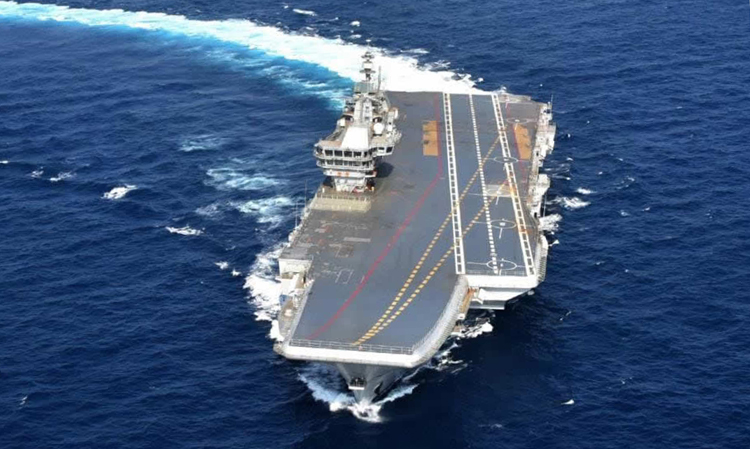
The countdown for the historical milestone towards the realisation of the Nation's commitment towards 'Atmanirbharta' has begun. September 2, 2022, will be a landmark date for the Indian Navy and the entire Nation, as the day will witness the Commissioning of the first Indigenous Aircraft Carrier (IAC-1) 'Vikrant', by the Prime Minister, Narendra Modi. Vikrant is the country's first indigenously-built aircraft carrier, designed and built for the Indian Navy at Cochin Shipyard Limited.
With the commissioning of 'Vikrant', India would join the select group of nations having the niche capability to indigenously design and build an Aircraft Carrier
Designed by the Warship Design Bureau (WDB), the Indian Navy's in-house organisation and built by Cochin Shipyard Limited (CSL), the Indigenous Aircraft Carrier takes its name after her illustrious predecessor, INS Vikrant (1961-1997) India's first Aircraft Carrier which played a vital role in the 1971 war.
Vikrant means victorious and gallant! True to its name, Vikrant is the largest warship to have ever been built in India. The ship's keel was laid in February 2009. The first phase of ship construction was completed with the successful launch of the ship in August 2013, followed by basin trials in November 2020, the sea trials and delivery of acceptance by the Navy in July 22. Delivered in 9 years of launching amidst the covid challenges.
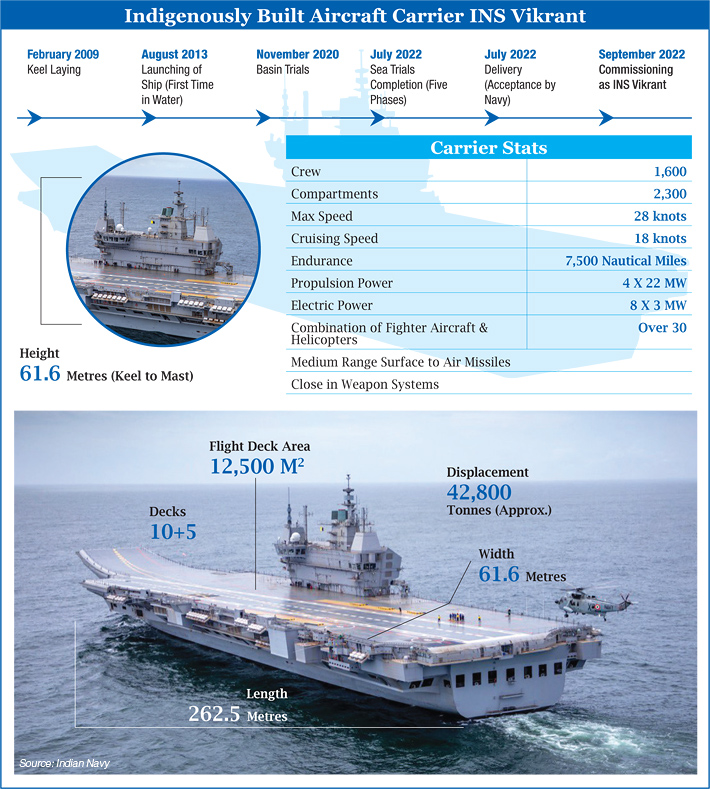
With the commissioning of 'Vikrant' on September 02, 2022, India would become the sixth nation, after USA, UK, France, Russia and China to have the niche capability to indigenously design and build Aircraft Carriers over 40,000T displacement.
The ship would be capable of operating an air wing consisting of 30 aircraft comprising of MiG-29K fighter jets, Kamov-31, MH-60R multi-role helicopters, in addition to indigenously manufactured Advanced Light Helicopters (ALH) and Light Combat Aircraft (LCA) (Navy). Using a novel aircraft-operation mode known as Short Take-Off But Arrested Recovery (STOBAR), the IAC is equipped with a ski-jump for launching aircraft, and a set of three 'arrester wires' for their recovery onboard.
Vikrant has almost 76 per cent Indigenous content, with joint contributions from 18 states and UTs, towards the equipment, making it a national effort.
"Vikrant has almost 76 per cent Indigenous content, with joint contribution from 18 states and UTs, towards the equipment, making it a whole of nation effort. A large number of indigenous equipment and machinery comes from major industrial houses in the country viz. BEL, BHEL, GRSE, Keltron, Kirloskar, L&T, Wartsila as well as over 100 MSMEs. The indigenisation efforts have also led to the development of ancillary industries, besides the generation of employment opportunities for 2000 CSL personnel and about 13000 employees in ancillary industries thus bolstering plough back effect on Nation's economy. A major spin-off of building an Indigenous Aircraft Carrier is the development and production of indigenous warship grade steel for the ship through a partnership between the Navy, Defence Research & Development Laboratory (DRDL) and Steel Authority of India Limited (SAIL), which has enabled the country to become self-sufficient for warship steel." Vice Chief of the Indian Navy, Vice Admiral S.N. Ghormade shared.
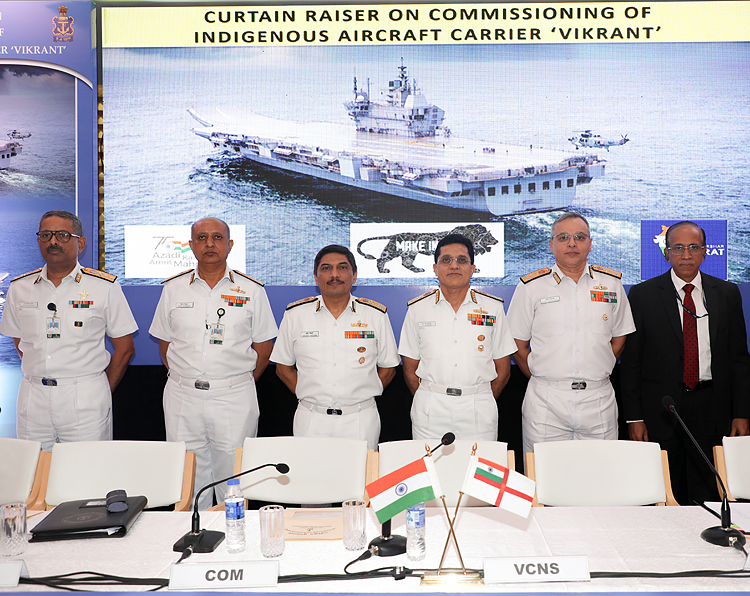
With the size of almost 10 Olympic size swimming pools, 262 m long and 62 m wide Vikrant displaces approximately 43,000T when fully loaded, having a maximum designed speed of 28 knots with the endurance of 7500 NM. The ship has around 2200 compartments, designed for a crew of around 1600 that include specialised cabins to accommodate women officers and sailors. The carrier is designed with a very high degree of automation for machinery operations, ship navigation and survivability. The carrier is equipped with the latest state-of-the-art equipment and systems. The ship is equipped with a fully-fledged Medical Complex with the latest medical equipment facilities that include major modular OT, emergency modular OT, physiotherapy clinic, ICU, laboratories, CT scanner, X-Ray machines, dental complex, isolation ward and telemedicine facilities.
Commissioning of 'Vikrant' would mark a Red Letter Day for the Nation showcasing the Atmanirbhar capability during the Azadi ka Amrit Mahotsav, 75th Anniversary of Indian Independence. The induction of Vikrant is a firm step toward strengthening the defence preparedness in the Indian Ocean Region and shall demonstrate Indian Navy's unwavering commitment to contribute towards peace and stability in the region.
Neetu Dhulia of SP's spoke to Vice Admiral S.N. Ghormade, Vice Chief of the Naval Staff, on the sidelines of the Curtain raiser.
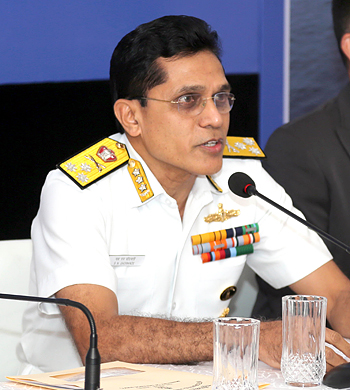
Where do we stand in terms of China's aircraft carriers, in terms of capacity and capability?
With India's first indigenous aircraft carrier, Vikrant ready for commissioning on September 2, 2022, the Navy believes the project for a third carrier should accelerate. China has got the fourth one now and our minimum requirement is three aircraft carriers. In the Indian Ocean Region, we have the geographical advantage and if we correctly position our IACs, we can optimally utilise their capability for deterrence.
What is the status of the Carrier Borne Fighters (MRCBF), now that the trials have been completed?
Trials for deck-based fighters for the Indian aircraft carrier are complete and it is under staff evaluation. We will take a decision as early as possible, likely this year.





